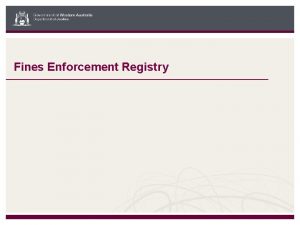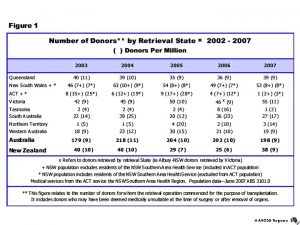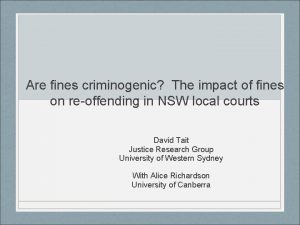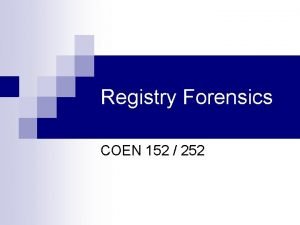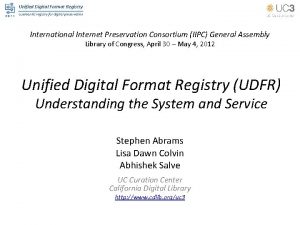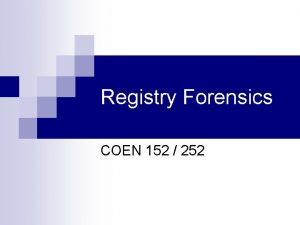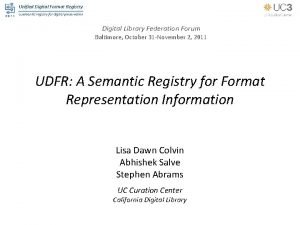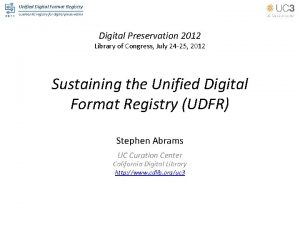Fines Enforcement Registry Introduction The Fines Enforcement Registry



















- Slides: 19

Fines Enforcement Registry

Introduction • The Fines Enforcement Registry sits within the Sheriff’s directorate of Court and Tribunal Services; • The Sheriff and Registrar’s authority to enforce infringements and court fines is derived from the Fines, Penalties and Infringement Notices Enforcement Act 1994 (WA)(the Act); • The Registry is considered a Registry of the Magistrates Court and the Registrar is an officer of the Magistrates Court; • The Act provides for the enforcement of infringements under Part 3, and the enforcement of court fines under Part 4;

Registrar’s Discretion • The Registrar does not have the authority to ‘waive’ a fine or infringement and does not have the authority to ‘waive’ fees; • If a client disputes an infringement they apply to have the matter heard before a court or they have to convince the Prosecuting Authority to withdraw the infringement; • If a client disputes a court fine they must appeal the decision to a higher court. • The Registrar has some discretion under the Act with regard to application of various enforcement sanctions and approving hardship time to pay applications, however in most instances the Registrar is obliged to continue enforcement.

What is an infringement? • An infringement is a notice issued under a written law alleging the commission of an offence and offering the person an opportunity, by paying a modified penalty, to have the matter dealt with out of court; • Infringements are issued by prosecuting authorities such as the WA Police, Department of Transport, Shires, Councils and other government agencies; • Clients can apply to have their infringements ‘revoked’ to court – that means that a court will then consider their guilt or innocence; • If the court finds them guilty of that offence, or they plead guilty, it then becomes a court fine.

Infringement Enforcement Process • Up to 4 notices can be issued for an infringement, before enforcement commences; • The initial infringement and a final demand from the PA; • A Court Order to Pay or Elect and a Notice of Intention to Enforce from FER. plus $21. 90 $88. 65

What is a court fine? • A court fine is a monetary penalty imposed on an offender by a court in criminal proceedings for an offence; • It includes any costs ordered to be paid by the offender in connection with those proceedings; and • Any amount ordered to be paid in connection with, or as a result of the offence. • If someone wants to dispute a court fine they have to appeal the decision of the Magistrate to a higher appellate court.

Fine Enforcement Process • A court fine is registered immediately with FER, giving an offender 28 days to pay before it becomes enforceable; • A Notice of Intention to Enforce gives the client an additional 28 days.

Fines and Infringement Enforcement • Licence suspension is generally the first enforcement sanction applied if an infringement or court fine remains unpaid or no payment arrangement commences; plus $46. 20

Time to Pay • The application must include an offer to pay the infringement and enforcement fees by regular instalments; • If the Registrar is satisfied that; • the client meets this condition; • has a reasonable excuse for any contravention of a previous time to pay order; and • The offer to pay be regular instalments is reasonable The Registrar must make a time to pay order and, as the case requires, suspend enforcement or cancel a licence suspension that has been made. • The Registrar may also consider the effect that a suspension would have on a client’s ability to seek or obtain employment.

Time to Pay – Form and Statutory Declaration • If a client is unable to offer a reasonable instalment, they may complete and submit a written application; • The application requests historical and current information regarding their payment history, the amount they wish to pay, and a supporting Statutory Declaration declaring their income, expenditure, assets and liabilities.

TTP – Points to consider • FER considers a number of things when agreeing to a Hardship application and setting up a Time to Pay: • Some clients have significant outstanding debts, we don’t like to set clients up to fail, so the figure has to be manageable • If they continually breach arrangements we will ask for an upfront figure before recommencing their arrangement or we will consider other enforcement options.

Enforcement Warrants • If an infringement is still unpaid after suspension, no TTP application has been received, and the client has aggregated outstanding infringements of more than $2000, Enforcement Warrants can be issued to the Sheriff; • If a court fine is still unpaid after suspension, an Enforcement Warrant can be issued to the Sheriff. • A warrant fee of $218 applies to each warrant. • Examples: • a $100 infringement is issued; • After adding on the fees, by the time a matter is converted to an Enforcement Warrant the amount outstanding is now $474. 75 • a $100 court fine is issued; • After adding on the fees, by the time a matter is converted to an Enforcement Warrant the amount outstanding is $364. 20

Sheriff’s Office • The Sheriff of Western Australia is responsible for the Execution of all Enforcement Warrants issued from FER. • The Sheriff has a network of officers state-wide, including; • Community Development Officers/Sheriff’s Officers (ACC) in the northern regions around to Kalgoorlie; • a contractor, Baycorp, in the southern half of WA; • Criminal Enforcement Team (CET) - Sheriff’s Officers in the Perth Metropolitan Area that also travel to some regional areas • Some Aboriginal Liaison Officers and Department of Transport (Do. T) officers also undertake work on behalf of the Sheriff and Registrar in remote areas.

Enforcement Warrants - Sanctions • Enforcement Warrants authorise the Sheriff to: • Lodge memorials (caveats), on real property and sell real property; • Wheel clamp a vehicle; • Remove vehicle registration plates; • Cancel a vehicle registration and return plates to Do. T; • Seize and sell personal property; • Make debts payable to a client, payable to the Sheriff. • Throughout the enforcement process, fees are applied and added to the existing debt. These include; • towing; • Advertising; • Auctioneer costs; • Memorial lodgement and withdrawal.

Stay of Execution Arrangement • A client is eligible to apply for a Stay of Execution (SOE) arrangement if their cases have progressed to an Enforcement Warrant. • If they fail to maintain their SOE the arrangement will be cancelled and enforcement action will recommence. • In a lot of cases, when a SOE payment arrangement commences, a TTP will also be loaded for any cases sitting with FER; • The TTP will remain ‘on hold’ until the SOE is completed and then the TTP automatically commences.

Portal • Clients can pay online, or apply for and set up a Time to Pay online: https: //ecourts. justice. wa. gov. au/e. Courts. Portal/

Portal

Points of Note • • • Once Enforcement Warrants have been issued, clients will not be able to set up an arrangement on line, they will need to contact FER to determine where the warrants are being held. Clients can pay by phone, BPAY, in person at a Courthouse, through regular direct debt instalments or via deductions from Centrelink Payments Enquiries can be emailed but response will not be immediate and can sometimes be in excess of a week Our aim is for fines to be paid or expiated through Work and Development, rather than Warrants of Commitment; Some clients request Warrants of Commitment, but we will reject in almost every circumstance as small payments via Centrepay are preferable, or Work and Development. Only court fines are eligible for a Work and Development Order and granted only if the client meets certain criteria for example – no capacity to pay.

Useful Contact Details
 Fines enforcement number
Fines enforcement number Hát kết hợp bộ gõ cơ thể
Hát kết hợp bộ gõ cơ thể Ng-html
Ng-html Bổ thể
Bổ thể Tỉ lệ cơ thể trẻ em
Tỉ lệ cơ thể trẻ em Chó sói
Chó sói Chụp tư thế worms-breton
Chụp tư thế worms-breton Chúa sống lại
Chúa sống lại Các môn thể thao bắt đầu bằng tiếng nhảy
Các môn thể thao bắt đầu bằng tiếng nhảy Thế nào là hệ số cao nhất
Thế nào là hệ số cao nhất Các châu lục và đại dương trên thế giới
Các châu lục và đại dương trên thế giới Công thức tính độ biến thiên đông lượng
Công thức tính độ biến thiên đông lượng Trời xanh đây là của chúng ta thể thơ
Trời xanh đây là của chúng ta thể thơ Mật thư anh em như thể tay chân
Mật thư anh em như thể tay chân Làm thế nào để 102-1=99
Làm thế nào để 102-1=99 Phản ứng thế ankan
Phản ứng thế ankan Các châu lục và đại dương trên thế giới
Các châu lục và đại dương trên thế giới Thể thơ truyền thống
Thể thơ truyền thống Quá trình desamine hóa có thể tạo ra
Quá trình desamine hóa có thể tạo ra Một số thể thơ truyền thống
Một số thể thơ truyền thống
